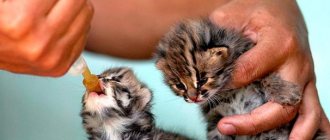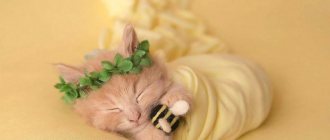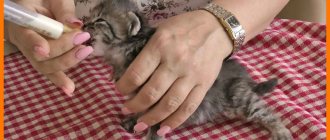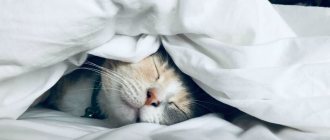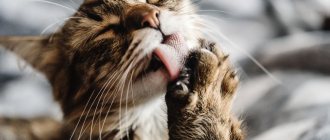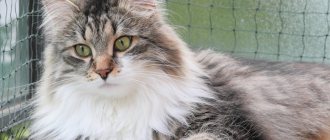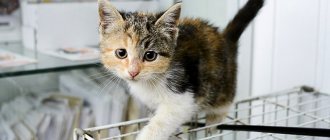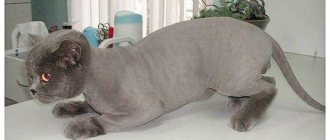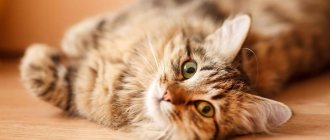Description of the technique
There are several methods of force feeding. For example, from the finger: with one hand the cat is held by the withers, and with the finger of the other hand the food is spread on the upper palate. However, this method can be traumatic for the cat. The best solution is to syringe feed. You can buy it at a veterinary pharmacy or use the usual medical option, of course, without a needle.
How to properly syringe feed a cat - this topic deserves special attention.
This process is not at all complicated.
First, the medical syringe will have to be modified a little:
- cut off the nose with scissors,
- widen the hole to the size of the needle protective cap,
- insert the needle cap into the resulting hole and cut off the tip.
Next, the technology is simple: the syringe is filled with pate or liquid food, which is then squeezed directly into the cat’s mouth. The elongated nose of the syringe will help you feed the animal conveniently, and will also protect the owner’s hands from sharp teeth and claws. While eating, a cat sometimes grabs the syringe with its paws for the purpose of self-defense.
If the cat trusts you and behaves calmly, then you can sit him on your lap, he will take food from your hands or from a syringe. He doesn't have to open his mouth wide. A small gap between the teeth will be enough, into which you need to insert a syringe . The instrument must be held correctly; it must be directed not directly into the larynx, but behind the cheek. The cat's face can be raised a little, but not thrown back too much.
Feeding cats with a syringe should be done calmly, without rushing.:
- It is better to pour in food in small portions so that the cat has time to swallow it.
- It is necessary to ensure that the liquid does not accidentally enter the animal’s windpipe.
- It is advisable to squeeze out the food at the moment when the cat exhales, and when inhaling, stop the food supply.
- If the cat swallows the food unsuccessfully and starts coughing. Feeding must be stopped, the animal must be allowed to come to its senses, clear its throat, calm down, and then the procedure can be continued.
The feeding process should be carried out several times a day in small portions.
Possible difficulties
Many pets do not like violence against themselves. The kitten hardly resists and can be easily dealt with, but proud adult cats will most likely react to the owner’s actions with indignation and offer active resistance. You need to call someone from the household for help to hold the cat. When animals see someone else besides the owner, they calm down a little and meow pitifully to evoke sympathy. It is much more difficult to resist two people than one - cats understand this and instinctively obey. So it won’t be difficult to feed a sick cat with a syringe.
If there are no helpers nearby, then you need to take a thick towel or blanket and wrap the cat tightly in it, leaving only the head outside. Then you can feed him without any hindrance. To open the cat's teeth, you need to place the palm of your hand on his head, and stick your index and thumb into the oral cavity behind the fangs. The cat's reflex will work, and the animal will open its mouth on its own.
During the procedure, it is not advisable to make sudden movements or raise your voice; a sick cat may choke from surprise and fright. You love your pet, so talk to him kindly. Hearing a calm, confident tone, the animal will calm down and swallow food normally.
A kitten and an adult cat should always maintain a normal water balance in the body. Dehydration can be a big problem, especially if you have a medical condition . If your cat refuses to drink water, add some liquid to the food. The bowl should always be clean and the water fresh. Cats are clean creatures, so they will not drink from dirty dishes. You need to change the water in the bowl every day.
To successfully fight the disease, your pet must be well fed, then after recovery he will be very grateful to you.
How and what to feed a sick cat?
High-quality, nutritious nutrition plays a huge role in maintaining a cat’s health and attractive appearance. But it becomes even more important when the animal develops health problems. During periods of poor health in a pet, the owner must pay special attention to its diet and ensure that the weakened body receives a sufficient amount of vitamins and nutrients. And during recovery, animals require more healthy, nutritious food than usual.
Often this pet’s eating behavior is a consequence of various diseases, especially those related to the gastrointestinal tract, as well as other health problems:
- 1. A foreign object in the throat or esophagus that the animal cannot remove on its own.
- 2. Serious body bruise.
- 3. Poisoning.
- 4. Stress.
If a cat does not eat anything, it must be shown to an experienced veterinarian, undergo an examination and pass all the prescribed tests: blood, urine, ultrasound.
If the animal’s portions have been reduced during illness, then there is no need to panic. It is important to ensure that your cat drinks plenty of water . This will avoid dangerous dehydration. If the pet categorically refuses any food intake, then in this case you will need to be patient and look for ways that will help feed the animal and prevent a lack of nutrients in its body. Among them:
- 1. Warm food, heated to approximately 39 ° C, becomes more aromatic and attractive to the cat.
- 2. If for some reason an animal has problems with its sense of smell, you should put small pieces of treats on its lips.
- 3. Sick cats are much more willing to eat liquid foods than solid ones, and they should become the basis of the diet.
- 4. If it is difficult for an animal to get up to get to the feeding area, the best solution would be to give it food from your hand, while stroking and calming the pet.
Sometimes the animal becomes so weak that it is unable to move independently or chew food. In this case, the owner must assist him in eating. It is convenient to use a miniature syringe for this. A 2 ml product will be sufficient.
The tip of the syringe is cut off with a knife, and the edges are cleaned so that they are not sharp. The tube is filled with liquid food, after which the product is brought to the animal’s nose. This is necessary so that your pet can smell the treat.
As soon as the cat opens her mouth a little, slowly squeeze a small portion of food onto her tongue. If the animal does not do this on its own, you will have to slightly open its jaws with your fingers. Do not press too hard to avoid causing pain to your pet. Otherwise, the next time the feeding procedure will cause negative emotions in him.
If you don’t have a syringe at hand, and the animal refuses to eat on its own, you can force the cat to eat in another way. To do this, you will need to take small pieces of soft food and place them on the root of the cat's tongue. Then you need to close your pet’s mouth and rub its throat with careful, gentle movements from top to bottom. This will make the swallowing process easier. You can give your cat tablets using the same method during treatment.
How to feed a kitten with a syringe: methods, portions, food, regimen
Feeding a kitten is the cat's responsibility. But what to do in cases where the parent is not around? Then the person has to take on the responsibilities of a mustachioed mother and feed the kitten on his own. There are many ways to feed a cat, but one of the simplest and most popular is to syringe feed the kitten.
Employees of the Murkosha shelter often encounter feeding kittens, since there are too many abandoned animals on the streets. Therefore, we can confidently say that this is a simple and effective method.
Which syringe to choose for feeding?
Syringes are used to feed not only kittens, but also adult cats. This happens in cases where the animal is sick and weakened so much that it cannot eat solid food on its own. This is why veterinary pharmacies sell special syringes for feeding. However, if you can’t buy a tool, you can use a regular medical syringe with a capacity of 10 milliliters or more. Of course, you first need to remove the needle from it.
Raising kittens without a cat. The best formula recipes for kittens
Milk comes out of the syringe when pressed, you gently press on the piston and the milk flows out.
It is important to remember that if there is a shortage of milk, supplementary feeding is a temporary measure, and the most important task is to restore breastfeeding in full.
Finger feeding is not suitable for flat and inverted nipples, because... it is possible to abandon the breast in favor of the finger. It also happens that due to pain in the nipples and severe cracks, the mother cannot feed, in this case, perhaps, some feedings need to be replaced with finger feedings, and the rest should be carried out from the breast, correcting the attachment.
Please note that when breastfeeding, a baby may prefer finger feeding to breastfeeding, i.e. the refusal will remain so, so it is usually more advisable to give the finger only for a while, and then supplementary feeding at the breast. If this does not work, supplementary feeding from a cup is preferable, which does not satisfy the baby's sucking reflex to the same extent. But, of course, we must take into account that the child should not starve, so if compared with bottle supplementation, finger feeding is better in any case.
In the application you can view all the photos of this post, as well as comment on and read other posts by the author
The Mamlife app is faster and more convenient
Open
When is syringe feeding necessary?
Force-feeding is, to some extent, violence against the animal, but it maintains strength well and provides the weakened body with nutrients. Syringe feeding a cat is recommended in certain situations:
- for long-term chronic diseases, including oncology;
- if severe exhaustion of the animal is detected;
- after injuries, especially to the head, teeth and jaws;
- during the recovery period after surgery;
- in the process of rehabilitation after strokes, paralysis and neurological disorders;
- small kittens aged 3-4 weeks, not yet capable of eating adult food.
Regime and diet. After consulting with your veterinarian, you should create a suitable diet and feeding regimen.
Typically, sick animals are fed small portions 3-4 times a day, and small kittens - 5-6 times a day with a 6-hour night break.
Suitable foods for sick cats include:
- cat pates from jars and bags;
- dry food granules soaked in warm water until thick sour cream;
- baby meat puree.
Technique for feeding a cat with a syringe
To force-feed a cat, it is convenient to use a regular disposable syringe with a capacity of 5 ml:
- The narrow nose of the syringe, onto which the needle is placed, is cut off with scissors, and the hole is widened to the diameter of the protective cap of the needle.
- The cap is inserted into the resulting hole and the very tip is cut off, resulting in a simple device for artificially feeding your pet.
- The container of the syringe is filled with pureed food, which, under the pressure of the piston, gradually moves and falls through the cap nozzle directly into the cat’s mouth.
Hungry little kittens and submissive animals easily swallow food while sitting on a person’s lap, but freedom-loving patients can push out the syringe with their tongue, chew the nozzle with their teeth and wrap their clawed paws around the syringe and the owner’s fingers.
Feeding rules. To ensure that the manipulation causes minimal inconvenience to the mustachioed, it is recommended to adhere to a number of rules:
- Artificial feeding should be carried out in a calm environment, talking affectionately to the animal.
- You should not open the cat's mouth wide - a small gap between the molars is enough, through which you can insert the syringe nozzle.
- To prevent the pet from choking, the food mass is not fed directly into the throat, but through the cheek, while the syringe is held at an acute angle to the animal’s head, and the cat’s muzzle is slightly raised.
- Semi-liquid food should be served using a piston in small portions, making sure that the cat has time to swallow it.
- If food gets into the windpipe and the animal chokes, then feeding should be stopped, giving the cat the opportunity to cough and restore breathing.
Feeding obstinate pets. Particularly wayward pets have to be swaddled in thick fabric, leaving only the head free. This will help protect against sharp claws and keep the animal in place during the procedure.
To get your cat to open his mouth, simply place your palm on his head and press with your index finger and thumb in the jaw area just behind the fangs.
The reflexive opening of the mouth will allow you to quickly insert the syringe nozzle between the teeth.
Also watch the video on how to feed a sick cat:
How to make a cat drink
To restore your cat's interest in water, first change the bowl . Animals usually prefer a bucket, pan, or vase. You can place different containers of water in different places.
You can add a little milk or broth to clean water. But such a drink should be changed often, as it quickly deteriorates, especially in a hot room.
You can offer your cat to drink water from the tap or install a special drinking fountain.
If the recommendations listed do not help, the cat must be force-fed using a syringe. This method is also often used for stress or toothache.
When force feeding is contraindicated
Animal instincts tell them a rational line of behavior, so a sick animal loses its appetite.
Old-school veterinarians do not recommend force-feeding cats, arguing that a sick body is not able to digest food, and an unbalanced metabolism will perceive food not as help, but as poison.
However, there are conditions where force feeding will actually do more harm than good. These are:
- Poisoning . In this case, actions are taken aimed at increasing the removal of the toxic substance from the body (artificially inducing vomiting, giving a cleansing enema, giving a laxative, intravenous infusions) and slowing down its absorption into the blood.
- Shock after injury . Pain and severe stress contribute to a sharp shift in metabolism and inappropriate behavior. As first aid, urgent measures are required to stop bleeding, fix the injured part of the body, as well as administer sedatives and cardiac drugs.
- Condition after anesthesia and surgery . Disorientation in space, dullness of sensitivity and disruption of muscle function lead to the loss of habitual behavioral reactions. Depending on the specifics of the surgical intervention, fasting is prescribed for 24-78 hours, and only after complete recovery from anesthesia and stabilization of the condition, dietary feeding with a gradual expansion of the diet is indicated.
- Acute gastrointestinal infection of a bacterial or viral nature . In this case, it is necessary to take emergency measures to relieve vomiting, diarrhea and general intoxication by introducing antibiotics, immunostimulants, sorbents, antispasmodics and detoxification drugs into the body.
- Attack of acute pancreatitis. For 2-3 days, the sick animal is shown fasting with intravenous administration of medicinal solutions, and only subsequently – fractional feeding in small portions.
Fattening
In order for the kitten to feel the taste of food and continue to draw from the syringe on its own, it is necessary to force it to take one sip. The syringe is brought to the animal’s nose, it smells the aroma of food, and it has to open its mouth. At this point, you need to drop a small amount of food onto his tongue, raise his head a little and stroke his neck down. This will lead to swallowing.
If an unimportant (= unimportant) animal wants to take food for some reason, you will have to saturate it with force. Don't be afraid to make him feel uncomfortable. Again, if a small pet does not eat, the beloved will weaken and begin to get sick.
What do you need to do to syringe feed your little pet?
- Open his mouth slightly.
- Next, insert the syringe, pointing it towards the sky or cheeks.
- A little food, no larger than a teaspoon, is squeezed out of the syringe.
- Before the next portion, the animal must read the previous one.
During such feeding, it is important to ensure that food does not enter the respiratory system. The head should not be thrown back too much. If the animal struggles, do not begin to sympathize with it; it is important not to forget that it directly needs food for life.
Special diet for cats
Currently, on the zoological products market you can find a huge number of different ready-made foods that were specially designed to help cats treat a particular disease or group of diseases. Among them there are those that should be given to those cats that, being in a state of stress, refuse to eat.
How and what to feed a sick cat.
This type of food is specially produced in liquid form. This is necessary so that a cat that refuses to eat can be syringed-fed or so that it can lap up the food like water. In addition, such food is very tasty, which can force the cat to eat at least a little. It should be noted that a cat that does not want to eat, as a rule, is more willing to eat something liquid, simply lapping it from a saucer, than to chew something solid. This circumstance should be remembered by all those who keep cats, just in case. Such foods, among other things, are characterized by increased calorie content.
Should a diet be followed if the cat is sick?
In view of this, even a small amount of such food will be enough to ensure that a sick cat is provided with all the essential nutrients. However, this does not mean that an owner who sees that his cat is unwell can simply run to the nearest zoological store, grab a package of such food and feed it to his pet, thinking that this will solve all the problems. This, of course, is the wrong approach and you should first consult with a veterinarian and, if the veterinarian deems it necessary, bring the cat for an examination. And only after the veterinarian gives the go-ahead for the use of such food, does it make sense to buy it. In this case, the doctor must indicate exactly how much of this food the sick cat should eat.
As a rule, the daily dose of food is divided into five to six small servings. And so that readers can get a more accurate idea of how to care for a sick cat, we will give a number of recommendations.
Firstly, to ensure that the cat does not lack nutrients, the owner will have to be patient, time and a certain ingenuity. He should also remember that:
- The food should be heated to approximately the cat's body temperature (about 38.5 degrees), which will make it more flavorful.
- If within fifteen minutes the cat has not eaten its food, then it (the food) can be removed. After some time, the animal can be fed again, and it is more likely to give preference to fresh foods rather than stale ones on the plate.
- Sometimes it makes sense to place small pieces of food on your cat's lips.
- Cats eat liquid food more readily than solid food, especially if the cat is sick.
- If the cat does not want to get up and go to the food bowl, you should feed it by hand.
What to feed
The ideal option for feeding very young kittens would be a special mixture containing seed. It can be purchased at a veterinary pharmacy. Eating such a mixture, the tiny pet will receive everything it needs. In any case, the mixture is an analogue of cat milk. It will unfavorably cause digestive disorders.
If it is not possible to purchase a special mash, it can be replaced with cow's milk. You need to add a little protein to it. Another suitable nutrition option is this mixture for newborns.
Feed quantity
The portion is determined depending on how much the pet weighs and what age it is. Now, for every 100 g of weight, a kitten aged 1-4 days should consume about 30 ml of the mixture. Every 9-10 days the amount of food must be increased by 8-9 ml.
Fattening consists of 2 parts, since during a small meal the pet usually wants to go to the toilet. After this, you need to stop continuing feeding.
During the first stage, the kitten eats more actively. And at the second stage he will eat much less. When he gets full, he starts sucking the syringe all wrong, and then starts to fall asleep.
If the kitten is completely healthy and usually eats normally, then leftover food should not be forced into it. If he no longer wants to be treated, he should be left.
Food temperature
When feeding kittens, it is important to monitor the temperature of the food. After all, the digestive organs of such babies are, again, not at all strong. Monitor the temperature of the food before each feeding.
During the first week of life, kittens need food at a temperature of about 39°C; if a pet is more than 2 weeks old, the food is heated to 30°C, and 3- and 4-week-old kittens need food at a temperature of 29 and 25°C, respectively. .
It’s not difficult to understand whether a kitten’s food is at normal temperature. The accordion should be applied to the bend of the elbow. He shouldn't act cold or hot.
Nutrition for rhinotracheitis
Rhinotracheitis or herpesvirus infection of cats. It has a milder course compared to previous diseases. The temperature and discharge from the nose and eyes also increase. There may be stomatitis. But in addition, swelling of the mucous membranes and larynx occurs. Swallowing is painful for a cat. Therefore, food is in soft or semi-liquid form.
What to give? Traditional low-fat broths, fermented milk products, soft-boiled eggs, pureed vegetables and cereals mixed with minced meat. Ready-made canned food in the form of pates.
The owner needs to remember that, largely thanks to timely vaccination, even with an incompletely formed immune response, the likelihood of death is low.
Feeding frequency
In order for a little nurse to develop well, it is necessary to feed him only high-quality food. There is another important point - the feeding schedule. During the first two weeks, feeding should occur up to 5-6 times a day. Then you can continue to feed the kitten every 3 hours.
A month old kitten should eat every 4 hours. Kittens who are about a month old can eat twice a day. At the same time, it will be possible to add special food for kittens of this age to the diet.
From time to time you decide to take such a small kitten into your home, it is respectable to remember that this is a big responsibility. After all, this is a helpless living creature that requires constant attention. To emerge as a healthy, well-mannered cat, you will have to put in a lot of effort. Think about whether you have time for this.


